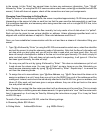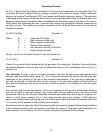
22
Other Gases: M Series Flow Meters can easily be used to measure the ow rate of gases other than
those listed as long as “non-corrosive” gas compatibility is observed. For example, a ow meter that
has been set for air can be used to measure the ow of argon.
The conversion factor needed for measuring the ow of different gases is linear and is simply determined
by the ratio of the absolute viscosity of the gases. This factor can be calculated as follows:
Q
og
= Q
1
[η
1
/ η
og
]
Where: Q
1
= Flow rate indicated by the ow meter
η
1
= Viscosity of the calibrated gas at the measured temp.
Q
og
= Flow rate of the alternate gas
η
og
= Viscosity of the alternate gas at the measured temp.
Say we have a meter set for air and we want to ow argon through it. With argon owing through the
meter, the display reads 110 SLPM. For ease of calculation, let us say the gas temperature is 25°C.
What is the actual ow of argon?
Q
og
= Actual Argon Flow Rate
Q
1
= Flow rate indicated by meter (110 SLPM)
η
1
= Viscosity of gas selected or calibrated for by the meter at the
measured temp.
η
og
= Viscosity of gas owing through the meter at the measured temp.
At 25°C, the absolute viscosity of Air (η
1
) is 184.918 micropoise.
At 25°C, the absolute viscosity of Argon (η
og
) is 225.593 micropoise.
Q
og
= Q1 (η 1 / η
og
)
Q
og
= 110 SLPM (184.918 / 225.593)
Q
og
= 90.17 SLPM
So, the actual ow of Argon through the meter is 90.17 SLPM. As you can see, because the Argon gas
is more viscous than the Air the meter is set for, the meter indicates a higher ow than the actual ow.
A good rule of thumb is: “At a given ow rate, the higher the viscosity, the higher the indicated ow.”
Volume Flow vs. Mass Flow
: At room temperature and low pressures the volumetric and mass ow
rate will be nearly identical, however, these rates can vary drastically with changes in temperature and/
or pressure because the temperature and pressure of the gas directly affects the volume. For example,
assume a volumetric ow reading was used to ll balloons with 250 mL of helium, but the incoming
line ran near a furnace that cycled on and off, intermittently heating the incoming helium. Because
the volumetric meter simply measures the volume of gas ow, all of the balloons would initially be the
same size. However, if all the balloons are placed in a room and allowed to come to an equilibrium
temperature, they would generally all come out to be different sizes. If, on the other hand, a mass ow
reading were used to ll the balloons with 250 standard mL of helium, the resulting balloons would
initially be different sizes, but when allowed to come to an equilibrium temperature, they would all turn
out to be the same size.
This parameter is called corrected mass ow because the resulting reading has been compensated
for temperature and pressure and can therefore be tied to the mass of the gas. Without knowing the
temperature and pressure of the gas and thus the density, the mass of the gas cannot be determined.


















